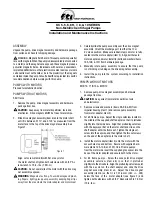
EN
4
– English
• The automation control unit does not turn on and the PSY24 battery
does not supply any signal.
This may depend on incorrect connections or electrical wiring not fully insert-
ed; otherwise the PSY24 battery may be completely discharged, without
sufficient energy to indicate the
battery low
status.
In this case, follow the quick recharging procedure, using the SYA1 battery
charger, or wait until the SYP photovoltaic panel, correctly connected, starts
to recharge the PSY24 battery.
• The PSY24 battery tends to discharge too quickly.
This may be due to excessive ageing of the battery, in which case replace-
ment is recommended; otherwise it may be due to excessively intensive use
of the automation, over the application limits envisaged in this manual, found
in Chapter 3.
• The PSY24 battery no longer recharges.
This may be due to a malfunction of the SYP photovoltaic panel caused by
incorrect installation, incorrect cable connections, or malfunction of the
PSY24 battery.
In general, these devices do not require special maintenance; however, reg-
ular checks over time will ensure system efficiency.
Therefore, to ensure correct maintenance, check every 6 months that the
SYP photovoltaic panel has not accumulated dirt (leaves, sand, etc.) as this
may reduce efficiency.
Also check whether PSY24 battery replacement is required, as the ageing
process reduces autonomy over time.
CAUTION
– The PSY24 battery must be replaced exclusively by skilled
and qualified personnel.
System device disposal
These devices are an integral part of the automation and therefore
must be disposed together with the latter.
As in installation, also at the end of lifetime of these devices, the disassem-
bly and scrapping operations must be performed by qualified personnel.
These devices comprise various types of materials: some of which can be
recycled while others must be scrapped. Seek information on the recycling
and disposal systems envisaged by the local regulations in your area for the
relative device category.
Caution!
– some parts of these devices may contain polluting or hazardous
substances which, if disposed of into the environment, may cause serious
damage to the environment or physical health.
As indicated by the symbol alongside, disposal of these
devices in domestic waste is strictly prohibited. Separate
the waste into categories for disposal, according to the
methods envisaged by current legislation in your area, or
return the devices to the retailer when purchasing new
equivalent versions.
Caution!
– local legislation may envisage serious fines in the event of abusive
disposal of these devices.
PSY24 Battery disposal
Caution!
– The battery contains pollutant substances; after removing, never
dispose of as standard waste. Dispose of or recycle according to current
local standards.
WHAT TO DO IF...
(troubleshooting guide)
PERIODIC MAINTENANCE
OPERATIONS
DISPOSAL
5 – General notes on system use
In general, when the PSY24 battery is not sufficiently charged, the energy
reserve will run out in a few days. For this reason, after installation and con-
necting the product to the automation, the system may not be operative
immediately (this depends on the fact that the battery may be discharged
due to the natural process of discharging over time, even when stored).
The PSY24 battery enables a finite number of automation manoeuvre cycles
(refer to the information sheet in the pack). Therefore, if not constantly
recharged using SYP or occasionally by means of SYA1, the
battery low
sig-
nal may be activated, with sequential flashing of the Led and a series of
beeps
(this signal may be temporary or permanent).
In particular, when powered by SYP, recharging may be influenced by atmos-
pheric conditions, or intense use of the automation (when the maximum
admissible number of manoeuvre cycles is exceeded). When this occurs,
PSY24 may indicate the
battery low
status.
PSY24 charging can be restored in one of the following ways:
A)
- By limiting use of the automation until lighting conditions improve to
enable the battery to recharge naturally, via the connection to the SYP
photovoltaic panel.
To accelerate the recharging process, disconnect PSY24 from the
automation control unit and wait for a few days to enable the SYP pho-
tovoltaic panel to store sufficient solar energy to recharge the PSY24
battery.
B)
- Disconnect the PSY24 battery from the automation control unit and the
SYP solar panel (if present). Then recharge PSY24 using the SYA1 bat-
tery charger connected to the mains in a protected environment.
When the PSY24 battery is recharging (via the SYP photovoltaic panel or
SYA1 battery charger) the red led emits 2 short flashes every 5 seconds.
Therefore check that this signal is present, also after installation, when the
panel is exposed to the sunlight.
The “
battery low
” warning signal is cleared when the system reaches suffi-
cient electrical autonomy to enable automation operation.
If the automation is not used for extended periods, disconnect the automa-
tion and photovoltaic panel connectors from the battery, and store the latter
in a cool and dry location.
Summary of Contents for Solemyo PSY24:
Page 1: ...Solemyo EN Installation and use instructions and warnings Autonomous power system SYKCE PSY24 ...
Page 10: ...X S E W N 90 90 90 90 4 5 6 ...
Page 11: ...XI 2 3 1 4 1 4 4 7 9 11 a 11 c 11 b 8 10 12 ...
Page 12: ...XII 205 mm 13 mm 13 mm 256 mm 128 mm 122 mm 230 mm 208 mm IN OUT 13 14 15 17 18 16 a 16 b ...






























